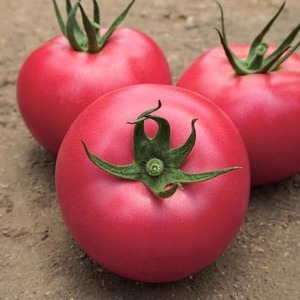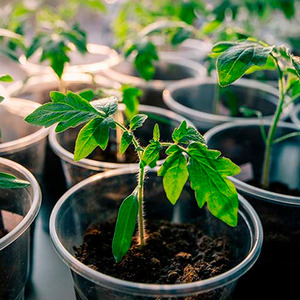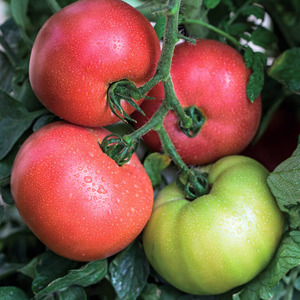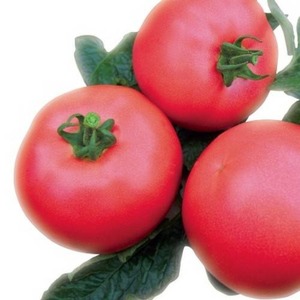An early ripe hybrid from French breeders - tomato "Alesi": an overview of the advantages, disadvantages and features
Many European tomato crops have conquered Russian garden beds. This is especially true of varieties of Dutch selection, which have successfully taken root in our latitudes. However, today we will be talking about the French tomato, namely, the Alesi hybrid.
Excellent taste and amazing color of the fruits make many gardeners abandon their usual varieties and plant an overseas hybrid that takes root well on Russian soil. The culture is interesting for one more feature - double fruiting: early and later.
The content of the article
Description of Alesi tomato
The f1 hybrid belongs to the work of French breeders from Vilmorin. Despite the peculiarities of the western climate, the tomato successfully takes root in the territory of the Russian Federation. Recommended for cultivation in open ground and greenhouse conditions.
Distinctive features
Indeterminate type, without limitation of growth, reaches 2 or more meters. The stem is strong, the foliage is moderate, the leaves are dark green in color. The inflorescences are simple, the first fruiting branch is formed over 6-7 leaves. Each hand sets 6–8 fruits.
An early ripe variety for spring and autumn turnover. When planted in March, fruiting ends at the end of July. With this method of cultivation, there is the possibility of obtaining a second (late) autumn harvest.
Productivity is high: up to 8 kg of fruits are harvested from 1 seedling. Fruiting is affected by the formation of a bush.
The hybrid is resistant to diseases of the nightshade family, for example: late blight, tobacco mosaic virus, verticillus and fusarium leaf wilt.
High growth of seedlings requires obligatory garter and pinching.
Fruit characteristics
Average weight - 150-200 g, flat-round shape, deep pink-red color. The taste is excellent, sweet, with a characteristic sourness. The pulp is dense, juicy, few seeds. The rind is thick, but not hard, does not crack.
Ripe vegetables can be stored for several months and can withstand transportation over any distance, perfectly preserving their presentation.
The use in cooking is universal. Tomatoes are consumed fresh, added to various winter preparations and processed for making juices, ketchups, lecho, adjika, pasta.
The photo shows the Alesi tomatoes.

How to grow seedlings
Like any other tomato crop, this hybrid is grown in the Russian climate through seedlings. Seeds cannot be prepared on their own, so you will have to buy them for each planting.
reference! Hybrid crops do not inherit genetic traits in the next generation.
Preparation of seeds, containers and soil
The purchased seed material does not need disinfection, since the manufacturer carries out the necessary preparation himself. To increase the germination percentage, the grains are soaked in a growth promoter for 10 hours. To do this, use not only specialized means ("Epin", "Zircon"), but also folk methods. These methods include:
- melt water - obtained from melted snow or ice and heated to room temperature. Withstand the seed for 10 hours;
- potato juice - the vegetable is frozen, then completely defrosted, finely chopped and passed through a garlic press. The seeds are placed in such juice for 9-10 hours;
- honey solution - 1 teaspoon of honey is dissolved in a glass of warm water. The seeds are kept in solution for 5-6 hours.
reference! Potato juice is rich in biologically active substances, and honey solution serves as an additional disinfection.
Any container is suitable for planting: a common wooden box or separate plastic cups and peat pots. Landing containers must be treated with a dark-colored manganese solution to destroy disease-causing spores. Then, at the bottom of each container, small drainage holes are made to drain excess moisture.
The hybrid is picky about the soil, namely its acidity... At the initial stage, the soil is slightly acidic or neutral. Therefore, the best option for planting is soil purchased in a specialized store. The further development of seedlings and fruiting depend on the soil composition.
reference! A litmus test will help determine the acidity of the soil. A little earth is dissolved in a glass of water, an indicator is lowered into the resulting mixture. Red color indicates high acidity (pH less than 4.0). A yellow color indicates weak values (pH 5.5–6.5), while in neutral soil the indicator will show a faint green color (pH 6.5–7.5).
The optimum acidity values for tomato cultivation are pH 5.5–6.5.
Sowing
The prepared soil is laid out in containers and the seeds are buried by 1.5 cm. Sprinkle with soil on top, slightly moisten with warm, settled water from a spray bottle and cover with a film. When creating a greenhouse effect, the seeds will sprout faster. The containers are left in a warm room at a temperature of +24 ° C.
Seedling care

When seedlings appear, containers are placed on the windowsill. Daylight hours for seedlings should be at least 13 hours. With insufficient sunlight, the seedlings will lag behind in development, so in this case it is worth taking care of additional lighting.
Water the culture with moderately warm, settled water from a shallow watering can. There is no need to overmoisten the seedlings: young roots can rot. In addition, excess fluid provokes the development of fungal diseases.
After watering, the soil is superficially loosened without harming the root system. This procedure improves the breathability of the soil.
When 2 true leaves appear, the seedlings dive, seating them in separate cups. In a common container, the distance between the seedlings is increased to 15 cm. During the pick, only strong and healthy plants are left that can survive and bear fruit in the open field.
2 weeks before transplanting, young bushes are hardened, taking them out into the open air in the daytime. You need to choose a calm day, without drafts. Duration of being on the street - first no more than 1 hour, then up to 10 hours.
How to grow tomatoes
Before planting seedlings in the ground, you should take care of the composition of the soil. The soil for a tomato should not only be nutritious and fertile, but also not exceed the permissible acidity. As mentioned earlier, this indicator is checked using a litmus test.
reference! Plants growing on the site will help determine acidity no worse than a specialized indicator. Sedge, sorrel and cornflower love acidic soil, clover, burdock and coltsfoot take root on slightly acidic soil, and nettles and quinoa take up fertile soil.
Landing
A complex of mineral fertilizers is introduced into the soil, dug up and make holes no more than 20 cm deep.
By the time of transplanting into the ground, the first flower cluster is formed on the bushes. This is an indicator of the readiness of seedlings for planting in a permanent place.
Choose a cloudy day for planting or transplant in the evening to protect the bushes from the sun's rays. They are planted in holes along with a lump of earth, compacted and watered with warm, settled water.Then the seedlings are left to adapt to the new place.
No more than 3 plants are placed per 1 m2 in a checkerboard pattern. This planting method allows everyone to receive the required amount of light.
Further care
The tomato is not picky about watering. Moisten the soil moderately, without flooding, as the topsoil dries out. After watering, the soil is loosened for better oxygen penetration. To keep the beds moist longer, they are mulched with straw or sawdust. Also, mulch serves as a barrier to the entry of pests into the beds.
The best way glaze - drip. To do this, a plastic bottle without a bottom is installed in the root zone and filled with water. The liquid gradually penetrates into the soil, feeding the roots evenly. With this method of irrigation, the moisture level in the beds will always be within normal limits.
Feed plant for the entire season at least 3 times. The fertilizer is a full range of minerals. During the flowering period, fertilizing with phosphorus is important, and at the time of fruiting, potassium substances are added.
To strengthen the roots, 10 days after transplanting, the seedlings are watered with a double rate of phosphorus fertilizers. If necessary, repeat the procedure after 2 weeks.
Features in care and possible difficulties
Formation should be given special attention, since this indicator affects the fruiting of the culture. When a bush is formed in 1 stem, the harvest will be early, and the fruits will be large, not less than 300 g. When administered in 2 stems, the fruits will be smaller, not more than 250 g, but there will be much more ovaries compared to the first option. When breeding a hybrid for sale, the bush is led in 2 stems.
Step sons plants regularly to prevent planting from thickening. In addition, the development of unnecessary lateral shoots takes away many useful substances necessary for the formation of fruits.
When transplanting, a wooden or metal support is installed next to each bush to fix the stem and fruiting branches... If the plant is not fixed, the stem may not hold up. Fruit-bearing branches under the weight will begin to creep along the ground, and the fruits, in contact with wet beds, can rot.
Diseases and pests
Despite its high resistance to diseases, the hybrid needs preventive measures. Moreover, in the areas, as a rule, many other crops grow that can spread infections.
To prevent the development of diseases, before planting, tomato beds are spilled with copper sulfate, which destroys fungal spores. The plants themselves are sprayed with non-toxic biological agents, for example: "Fitosporin", "Gamair" or "Phytocide".
reference! "Fitosporin" is used not only for prophylactic purposes - it is used to combat many fungal infections (late blight, root rot, Alternaria and Fusarium). In addition, the product strengthens plant immunity.
Loosening, hilling and mulching beds. Moderate watering with moisture control keeps bacteria from growing.
The greenhouse pest - spider mite - is dangerous because it is not always noticed on time. Since it spreads too quickly, a large number of landings suffer. Therefore, closed structures are ventilated on a daily basis, without creating a draft.
The Colorado potato beetle is harvested by hand, carefully examining each seedling from all sides. In case of a large accumulation of insects, use the Prestige insecticide.
A soap solution (1 piece of laundry soap per bucket of water) saves from aphids, with which the stems of plants are treated. Spraying with an infusion of onion husks or nettles helps with many pests. To do this, add 2 liters of hot water to 1 liter of onion husk, infuse the mixture for 2 days.
Outdoor and greenhouse cultivation
If you pinch the top of the seedling after the formation of 6 fruitful branches, then the plant will spend all its energy on the formation of existing ovaries, and not on further growth. This technique is used if the crop is grown in a short period, that is, when the harvest is supposed to be completed before the end of July.
If the culture is grown throughout the season, then 7-8 fruitful branches are left. This will noticeably increase the time of fruiting, but the tomatoes will be smaller.
With increased acidity, dolomite flour or slaked lime must be added to the soil. Otherwise, the hybrid will not survive in an acidic environment.
Tomatoes should be planted in those beds where cabbage, celery, onions or legumes previously grew... After these crops, the soil is saturated with nitrogen, which is necessary for the full development of any nightshade. According to the rules of crop rotation, it is not recommended to plant a tomato twice in the same place: as it grows, the vegetable draws out all the nutrients from the soil and the soil after it is very depleted.
Harvesting and application of the crop
When breeding a hybrid for sale, the collection of vegetables is carried out in a state of milk ripeness. Unripe tomatoes lie longer and withstand transportation perfectly. They are able to mature on their own without losing their taste. In addition, the unloaded bush ensures faster ripening of other fruits.
For the purpose of personal use, tomatoes are allowed to mature completely, using them in the preparation of various dishes, slices and freshly squeezed juices. Tomatoes look great in whole-fruit canning, they do not lose their taste in pickles and marinades. They are used for processing for tomato products, making juices, adjika, pastes and sauces.
Advantages and disadvantages
Among the positive qualities of culture are:
- possibility of double turnover;

- high rate of fruiting;
- disease resistance;
- uncomplicated agricultural technology;
- settling in any climate;
- drought resistance;
- excellent fruit taste;
- uniform ripening;
- long keeping quality;
- versatility in application;
- safety during long-term transportation.
The main disadvantage of the hybrid is its dependence on the composition of the soil. This also includes the compulsory formation, pinching and garter of plants.
Farmers reviews
Gardeners quickly appreciated the culture for its maximum impact and the ability to harvest excellent fruits twice:
Mikhail, Moscow: «A very good hybrid for sale. Vegetables ripen quickly, have a long shelf life, and can be transported far. Since the immune system is stable, there is no need to worry about various diseases and negative natural factors. "
Vera, Volgograd: “I've been planting the hybrid for several years. Taste quality is excellent, keeping quality is good. The variety is disease resistant. Vegetables do not crack, excellent pink color. The only negative is that I can not collect the seeds myself. But while the price is affordable, I will buy. "
Conclusion
Tomato Alesi f1 has absorbed the most worthy characteristics: unpretentious care, resistance to major diseases (late blight, fusarium, tobacterial mosaic and verticillosis), a high fruiting rate (from 1 m2 to 20 kg of fruits).
The hybrid takes root easily in any climate. Its main advantage is the ability to bear fruit twice. Vegetables are suitable not only for home use, but also for profitable sale, since they do not lose their presentation during transportation and are able to ripen on their own.